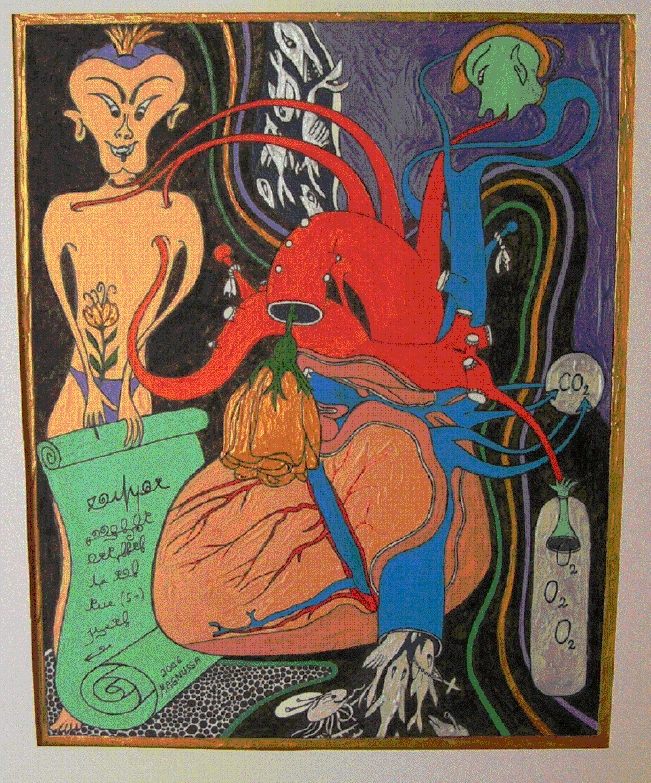
Dialysis

On dialysis, Zehra felt as if her body was no longer her own, as if the body she had once known as her own was slowly being replaced in the cycles of dialysis. She disliked the blue dialysis machines, which had fluids different from those used in newer "white" machines. After six months of suffering with the blue machine and low blood pressure, she was switched to the white machine.To avoid interaction with other patients, Zehra tried to sleep during dialysis. Most of the time, she dreamt of herself on dialysis. In this recursive dream, the needles would come out suddenly and she was hindered from fixing them because she was attached to the dialysis machine. Desperately, she would look around to find the nurse who could help her put the needles back in her arm. Even though blood would pour from the opening on her fist, she felt no pain in her dream. When she woke up everything would be normal. Once while having a similar dream during dialysis, the dream materialized: Zehra woke up to find that her needles had come undone. Unlike in her dream, there was no blood. Just as in her dream, she did not feel pain.
After a while, Zehra began to feel kinship ties to the other dialysis patients --- a "new family" as her fellow patients called themselves. The repetition of dialysis teaches the sufferers to recognize the same kind of suffering on the faces of their fellow patients. Beyond this, for dialysis patients, a new kinship is based on sharing a cyborg-like life and dreams that reveal suppressed feelings about this life. During their three-hour dialysis sessions, always scheduled for the same times every week, patients talk about family, pain, kidney thefts, the "organ mafia," the rich and their luck, school, flirts --- in short, about everything one would talk about with close friends. Even though these patients have not known each other for long, they feel intimately connected. The family metaphor is reinforced through lack of choice: just as one cannot choose one's own parents, one cannot really choose one's companions in dialysis.
Zehra was not very talkative during her dialysis sessions. She wondered to herself if she was introverted because a childhood fever had left her with a limp, or perhaps she was simply too shy to ask questions. She preferred to sleep despite her nightmares. She wanted a dream state and silence, but the dede (a grandfather, or an Alevi saint), her next-bed neighbor, was a talkative older man, and it would be disrespectful to close one's eyes and pretend to be asleep while he was talking to her. So sometimes she would listen to him, and sometimes Zehra would try to sleep.
One day, during dialysis, Zehra turned her head toward the dede and saw something miraculous. He had changed. Now, his nose was just like hers, curved; it had changed its shape. His hands became like her hands, his thumbs became like hers, which were flat and narrow, and he had henna all over the inside of his palm. It occurs to her that he might be more than dialysis kin. Had she not realized before how similar they (the dede and herself) were, and how different she was from her own family? She felt related to the dede and not to her own parents. Even though she was not taking any drugs known for their hallucinatory effects, Zehra preferred to keep her insight about the dede a secret from the doctors. She thought she might be laughed at or put on more medication. This experience marked, for Zehra, the beginning of feelings that Virginia Woolf expressed when she described a moment: "when life sank down for a moment, the range of experience seemed limitless."
Zehra saw other things. The doctors' skin and hair color would change as they approached her. At a distance, one doctor looked dark-skinned with dark eyes, but as he came closer his hair turned grey and his eyes became green. Another time Zehra saw a group of doctors who were all dressed the same: all were in black --- an unusual color for the hospital. She was sure there was a change, but she was not sure of its cause. Was it the light or herself? If it was the light, it was merely an optical illusion. But if it was herself and if exterior objects were indeed changing to reveal their true appearance to her, then she had insight into the miracles of a world unseen by others. In this second case, she would not be able to talk to anyone about what she was seeing. Zehra began to wonder whether she was losing her sanity or whether the world was revealing its secrets. She felt a deep desire to know the truth. On several occasions, she had already felt the dark ether of death next to her bedside.
--- From The Inner History of Devices
Sherry Turkle, Editor
©2008 MIT Press